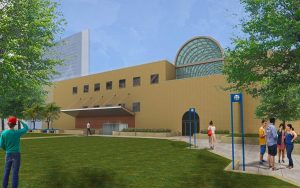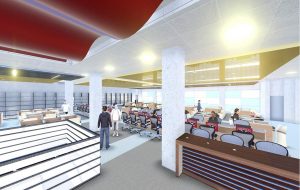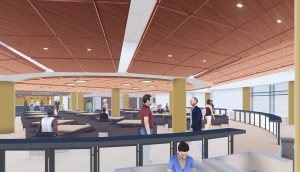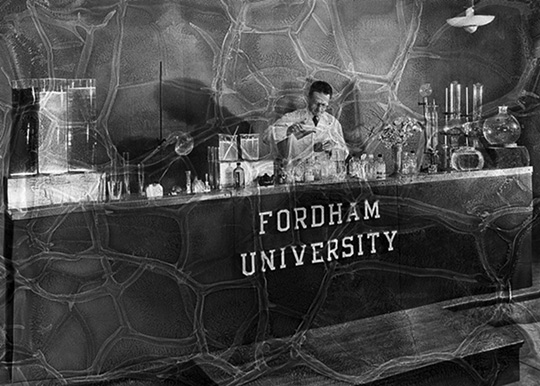The $81,000 grant, part of the Humanities Open Book Program, will allow the press to make publicly accessible eBooks out of 21 previously published titles with an emphasis on American philosophy. Many of the titles chosen are books already out of print, said Kate O’Brien-Nicholson, associate director of the press.
Among those books being revitalized in ebook form are: Peirce and Contemporary Thought by Kenneth L. Ketner (1994);The Metaphysics of Experience: A Companion to Whitehead’s Process and Reality by Elizabeth Kraus (1997); and Charles S. Peirce: On Norms and Ideals by Vincent G. Potter (1996).
“Books on American philosophy became the natural choice, as our selection process revealed that the titles in the series have lasting and universal appeal,” said O’Brien-Nicholson. The books were selected based on both circulation records and sales records, she said.
The press has published more than 3,000 scholarly books since its founding in 1907 and has long been recognized as a leading American publisher of philosophy scholarship, she said.
Library Director Linda LoSchiavo said the grant will help grow and broaden the library’s digital collections.
“The out-of-print titles, which will become available freely through the library’s open access institutional repository, DigitalResearch@Fordham, represent some of the leading scholars and thinkers in the field of philosophy,” she said.
]]>
The project involved completely gutting the building, which dates back to 1961. And while much of the work on the exterior has been completed, the construction continues unabated on the inside. Recently, Joseph Scaltro, Director of Engineering Services at Lincoln Center led a tour of the site.
[doptg id=”46″]Photos by Bob Howe
]]>The photographs, which were first shown this time last year, pay homage to the 369th Infantry Regiment that fought in both world wars and broke ground for African Americans seeking to serve in the U.S. military.
]]>
140 West 62nd Street, the home of Fordham Law School for over five decades, is poised for a new life.
The building is in the midst of a two-year-long, $70 million renovation that will transform it into a home for the Gabelli School of Business, a new student center, and an expanded Quinn Library.
It’s the second major renovation for the space, which first opened in 1961 and was expanded in 1985. Brian Byrne, vice president for Lincoln Center, said a full gut renovation was needed because the original structure was designed to meet building codes from 1938. Though it was “well-maintained but care worn,” it is getting new heating, mechanical and air conditioning systems, as well as steel reinforcements of several floors.
It will be more energy efficient too. A new reflective roof will be installed, along with a generator that will allow the University to disconnect from the city’s power grid on days when extreme heat is straining the grid.
On the building’s exterior, a new glass-curtain wall on the north side will open up interior space to more light. On the south side, a new entrance, made possible by the removal of the law school library’s stacks, will connect the building to the Robert Moses Plaza for the first time.
Gabelli School of Business
For the Gabelli School, 140 West 62nd will combine with the newly acquired building across the street at 45 Columbus Avenue to create a defined home base at Lincoln Center. 140 West 62nd Street will draw together classrooms and social areas, meeting rooms for group projects, a suite for academic and career advising, and boardroom-style space all under one roof. Technology will be prominent, with one room reserved for a bank of 42 Bloomberg machines.

The additions will support the expansion of the Gabelli School at Lincoln Center in both directions. The undergraduate population is increasing—about 170 freshmen and sophomores are enrolled in the new BS in Global Business program, with two classes to be added by fall 2017. On the graduate end, two doctoral programs are pending New York State approval: a PhD and a Doctor of Professional Studies degree. These students will work alongside one another in the new building, reflecting the unification of the undergraduate and graduate business schools that took place in February 2015.
“This building is designed to encourage interaction,” said Donna Rapaccioli, PhD, dean of the Gabelli School. “There is an advantage to having faculty, doctoral students, master’s students, and undergraduates in the same space to share ideas, and there is an added benefit from the layout of the building itself—it was designed to support teamwork, which, as we always remind our students, is an inescapable feature of today’s business world.”
Quinn Library
Three new floors of space for the Quinn Library will enable researchers and staffers to come in out of the basement—literally—into the daylight, thanks to the building’s atrium.

Linda LoSchiavo, head of the Fordham Libraries, said that moving out of the lower level of the Lowenstein Center will make Quinn a dramatically different and more dynamic environment, where each of its three floors will have its own distinct feel.
The first floor will contain the book stacks, PCs, study areas, and a small café space. The second floor will feature the reference, reserve and circulation desk. And the third floor will have a quiet zone for studying. The current space confines everything to one open, windowless room that is much too small, she said.
“We are combining the traditional aspects of a library and of library services with a new culture that leans more toward a learning commons,” LoSchiavo said. “We’re finding that there is a lot of learning taking place outside of the classroom. Libraries in general have become integral links to the academic enterprise.”
Student Center
On the ground level, the student center space will expand by approximately tenfold, said Keith Eldredge, dean of students at Lincoln Center. When McKeon Hall opened last year, the residential population at Lincoln Center ballooned from 850 to 1,200 students; another 100 are expected to move in next year.
To accommodate them, the former law school cafeteria is being transformed into a large multipurpose room that can accommodate up to 250 people, and small meeting rooms.

The Departments of Career Services, Multicultural Affairs, Student Leadership, and Health Services and Counseling will also move into the space, making it easier to provide seamless service to students.
Dedicated space for student clubs is also a big draw, said Eldredge. He noted that the yoga club currently has to meet in a classroom in the Lowenstein Center.
“The chairs have wheels on them, so they are pushed to the corner and everyone brings a yoga mat. But you know, the fluorescent lights of a classroom with a smart board in the front of the room isn’t the most conducive space for it,” he said.
“A carpeted room that’s more multipurpose can be used for a student group meeting at a table, for yoga, or for small presentations,” he said. “The new space will give us more versatility.”
]]>
In the spirit of the holidays Fordham University Libraries is displaying a rare first edition of Charles Dickens’ A Christmas Carol in the atrium of the Walsh Library. Daniel “Danny” Madden, GSB ’84, donated the book to the University earlier this year as a way of “conveying my love of my time at Fordham and of two people who were generous beyond words.”
The two people that Madden was referring to were Marion and Bernie Hutner, a couple who lived on Sutton Place South where Madden worked as a doorman during college. The Hutners took a shine to Madden, who returned their kindness by looking out for the couple in their old age. Over the years Marion gave Madden several books from the couple’s collection, including A Christmas Carol.
Madden delights in giving listeners an Irish earful and tells the tale of Marion Hutner with particular relish. She was born Marion Beard in Cleveland, Ohio, and came from modest means. She danced in Paris, sang on Broadway, and became a Ziegfeld Follies girl before settling into her 50-year marriage with Bernie. Before his death in 1989, Madden said Bernie “charged” him with caring for Marion because he would not be around much longer. He died two weeks later.
Marion would continue to turn heads well into her seventies, said Madden. She never left the building without a hat on. And when she did leave the building, she modestly did so though the back service entrance, which endeared her to the building’s doormen.
“She came from poverty and never went out the front door,” said Madden. “But when she died they took her out the front and all the doormen lined up—Tommy, Gus, all of us. They were all there sobbing. It was a sight to see.”
Madden said that when Marion died more than $20 million was given to New York charities. Her ashes were spread in areas of New York, Cleveland, a small park in Paris, and in Ecuador outside of a day care center she funded.
It would seem that the life of Marion Hutner was antithesis of Ebenezer Scrooge.








]]>
With over 2 million books spread among three main branches, Fordham University Libraries is the fourth largest system in New York State. All of these books must be processed, of course, and since 1964 about 30 percent of them passed through the hands of Carole Lazarou in the cataloging department.
Now, after 50 years, Lazarou is calling it a day. Her retirement starts today.
Linda LoSchiavo, the director of libraries, said that it’s astonishing to think about the changes that Lazarou has witnessed. She noted that Lazarou is one of the last people in the library who actually knows how to type out a catalog card—on a manual typewriter, no less. From manual to electric typewriter, and from DOS computer systems to today’s sleek digital systems, Lazarou has done it all with steadfast efficiency.
“She’s made the changes seem natural,” said LoSchiavo. “There was never any resistance. It was always ‘This is the way it is’ and she very quietly went about her work.”
Lazarou, a native of Yonkers, said she remembers being nervous on her first day work; at the time, she was stationed in the basement of Keating Hall. She said she loved the Christmas parties because it was a time when “you see everybody,” something of a treat for someone whose job required the processing of volumes of materials and which was often a solitary undertaking. Her favorite books were the art books, with Michelangelo being her favorite artist.
When John Williams became director of cataloging in 2010, he said that when he contemplated all the many details of running the department, his mind was put at ease when Lazarou said: “I’ll do that.”
Always early to the office and rarely missing a day of work, Lazarou said she has no intention of slowing down. She’s very much looking forward to spending more time at her Yonkers fitness club.
“She leaves with a smile on her face, on her own two feet, and with a building full of friends,” said LoSchiavo.
—Tom Stoelker
]]>
Social workers often find themselves on front lines of where the hard numbers of economics meet people’s complex social and emotional needs. Yet, many students venturing into the field of social services often eschew the literature of other disciplines, like economics, that directly affect their clients. Now, a new journal supported by the Graduate School of Social Service (GSS), titled 21st Century Social Justice, seeks to merge social work research with that of neuroscience, economics, and law.
“During my research into social work, I have found it impossible not to wander into the literature of other fields,” said Zachary Alti, GSS ’14, the founder and editor of the inaugural issue.
“But neuroscience can seem intimidatingly scientific, and the cold realism of economics can be perceived as antagonistic to social justice.”
Alti approached Tina Maschi, Ph.D., an associate professor at GSS, with his concerns that there was a knowledge gap in social work research that needed to be filled. With the support of Fordham University Libraries, Maschi helped facilitate the message and the mechanics, while Alti recruited fellow students.
He issued a call for papers and wrote the opening statement. An editorial board of fellow students was formed so that papers could be peer reviewed. Maschi said that developing a student-led journal was already a goal at the school, but it was Alti’s initiative that brought together a “convergence of ideas.”
“This is a beyond the classroom learning experience,” she said. “Students need to realize their own knowledge and their power, and know that they have something to offer the other sciences. They’re the scholars. They have a valid, expert role in sharing their views with these other fields.”
Getting the various disciplines to join a scholarly endeavor led by social workers can to be a challenge, she said. But she added that social workers play a vital role in translating the science and economics to communities that are directly affected.
“Social work is a psycho-social-spiritual medicine,” she said. “It’s important to recognize that social work plays a primary role in preventing illness and promoting health and well being. The journal is just another step towards social workers being accepted as full and equal partners in knowledge generation.”
The inaugural issue highlights several topics, including little known social problems related to families caring for a fragile infant, breastfeeding women in the workplace, conditional cash transfers among women in Columbia, and the effect of climate change on vulnerable populations.
“Psychologists are often perceived as the industry standard for therapy,” said Alti. “I wanted to strengthen the view of social work as different from psychology, in that it has a distinct framework. We’re a much more externally oriented field, always looking at the environmental factors at play. We want the journal strengthening that distinction with knowledge from other fields.”
With Alti recently graduated and in private practice, student Merritt Juliano will take up the role of editor. Juliano is accepting papers for the next issue at [email protected]. All disciplines are welcome to submit.
from the Fordham University Archives and Special Collections
The Ildiko Butler Gallery at the Lincoln Center Campus
Exhibition dates: June 6 – July 18, 2014
Website: http://fordhamuniversitygalleries.com
William Fox was a freelance photographer who worked in the 1930s and 1940s for Fordham during the Robert Gannon, S.J. administration, for upwards of 20 years. He left his negatives and photographs to Fordham’s library decades ago—coverage of commencements, campus architecture, student life, and more.
Some of the works taken in 1940-1941 are on display in a new summer exhibit, curated by Stephan Apicella-Hitchcock. He said he chose prints that, through surface fissures and bubbles, display the “flaws of the analog process” in contrast to “our digital age of precision and perfection.”
Below is an old print of a laboratory on the Rose Hill campus.
]]>